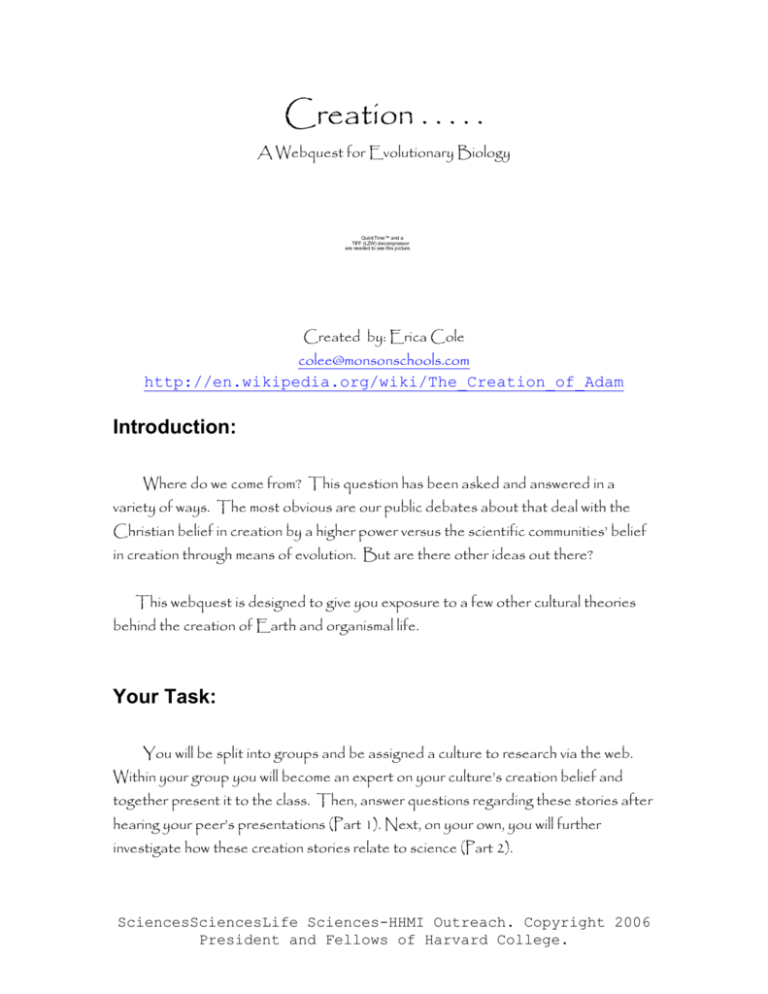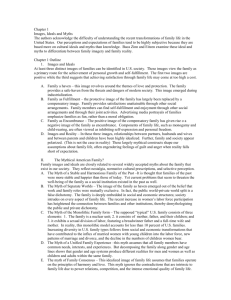Creation Myths - Life Sciences Outreach Program
advertisement

Creation . . . . . A Webquest for Evolutionary Biology QuickTime™ and a TIFF (LZW) decompressor are needed to see this picture. Created by: Erica Cole colee@monsonschools.com http://en.wikipedia.org/wiki/The_Creation_of_Adam Introduction: Where do we come from? This question has been asked and answered in a variety of ways. The most obvious are our public debates about that deal with the Christian belief in creation by a higher power versus the scientific communities’ belief in creation through means of evolution. But are there other ideas out there? This webquest is designed to give you exposure to a few other cultural theories behind the creation of Earth and organismal life. Your Task: You will be split into groups and be assigned a culture to research via the web. Within your group you will become an expert on your culture’s creation belief and together present it to the class. Then, answer questions regarding these stories after hearing your peer’s presentations (Part 1). Next, on your own, you will further investigate how these creation stories relate to science (Part 2). SciencesSciencesLife Sciences-HHMI Outreach. Copyright 2006 President and Fellows of Harvard College. Part 1 Find your group below and follow the instructions to complete your task. APACHE 1 Go to http://www.indians.org/welker/creation.htm and read the Apache Creation Story. 2 Create a visual representation of this creation story that encompasses the entire myth to present to the class. This may be a series of drawings, a physical reenactment, or any other number of things provided that you do not simply rely on reading the myth to the class. NORSE 1 Go to http://www.gly.uga.edu/railsback/CS/CSOdin&Ymir.html and read the Norse story about the origin of the earth, sky and humanity. 2 Create a visual representation of this creation story that encompasses the entire myth to present to the class. This may be a series of drawings, a physical reenactment, or any other number of things provided that you do not simply rely on reading the myth to the class. KOJIKI, JAPAN 1 Go to http://www.gly.uga.edu/railsback/CS/CSJapan.html and read the Japanese story about the origin of Japan and her people. 2 Create a visual representation of this creation story that encompasses the entire myth to present to the class. This may be a series of drawings, a physical reenactment, or any other number of things provided that you do not rely on simply reading the myth to the class. YORUBA 1 Go to http://www.gly.uga.edu/railsback/CS/CSGoldenChain.html and read the Yoruba story about the golden chain. 2 Create a visual representation of this creation story that encompasses the entire SciencesSciencesLife Sciences-HHMI Outreach. Copyright 2006 President and Fellows of Harvard College. myth to present to the class. This may be a series of drawings, a physical reenactment, or any other number of things provided that you do not rely on simply reading the myth to the class. HOPI 1 Go to http://www.gly.uga.edu/railsback/CS/CSFourCreations.html and read the Hopi story about the four creations. 2 Create a visual representation of this creation story that encompasses the entire myth to present to the class. This may be a series of drawings, a physical reenactment, or any other number of things provided that you do not rely on simply reading the myth to the class. CHINA 1 Go to http://www.dreamscape.com/morgana/ariel.htm and read the Chinese creation story. 2 Create a visual representation of this creation story that encompasses the entire myth to present to the class. This may be a series of drawings, a physical reenactment, or any other number of things provided that you do not rely on simply reading the myth to the class. CHRISTIAN 1 Go to http://etext.virginia.edu/toc/modeng/public/KjvGene.html and select Chapter 1. Read the Christian creation story. 2. Create a visual representation of this creation story that encompasses the entire myth to present to the class. This may be a series of drawings, a physical reenactment, or any other number of things provided that you do not rely on simply reading the myth to the class. QUESTIONS: (Please answer on a separate piece of paper) 1. What do all of these stories have in common? 2. Which story makes the MOST sense to you as far as explanation of origin of the Earth and Organisms? Which makes the LEAST sense? WHY? SciencesSciencesLife Sciences-HHMI Outreach. Copyright 2006 President and Fellows of Harvard College. 3. Which stories had you heard about prior to this class? Which ones were new? 4. Which story was the most INTERESTING to you? Why? 5. Which myths leave you with unanswered questions? List a few of your questions as examples. Part 2 – Once you have presented your Origin story to the class, go to http://www.ncseweb.org/resources/articles/3570_origin_myths_12_7_2000.asp and read the article by Robert Carneiro on Origin Myths. On your own, please answer the following questions on a separate piece of paper. 1. What do science and creation stories have in common? 2. What is meant by personal causation and impersonal causation? 3. What does imagination have to do with creation stories? With science? 4. How are myths important to society? How is science important to society? 5. What does the Earth being the center of the universe (in these myths) signify? 6. What are the 3 types of myths surrounding the origin of humans? Using the myths we heard about from above, classify each myth into one of these 3 categories and explain why they fit in that category. 7. Why are myths believable? Why is science sometimes not believable? 8. Does Robert Carneiro have a bias of opinion based on what you’ve read in his article? In other words, do you think he is FOR or AGAINST the truth being found in these creation stories. Be sure to support your answer with direct quotes and/or examples from the text. EXTRA CREDIT It is sometime in the near future and life on other planets has just been discovered. Write your own creation story, how does the Earth and Human evolution relate to these new alien life forms? Do we all evolve the same way? Where do we fall in place with these new life forms, or where do they fall in relation to us? Be creative! It must be typed, (min. 2 pages, 1.5 spaced) include illustrations (space is not to be counted in your 2 typed pages!) and it must be original. SciencesSciencesLife Sciences-HHMI Outreach. Copyright 2006 President and Fellows of Harvard College. Evaluation: Presentation (24points) QuickTime™ and a TIFF (LZW) decompressor are needed to see this picture. SciencesSciencesLife Sciences-HHMI Outreach. Copyright 2006 President and Fellows of Harvard College. Evaluation: Reading Essay & Written response Questions (28 points) QuickTime™ and a TIFF (LZW) decompressor are needed to see this picture. QuickTime™ and a TIFF (LZW) decompressor are needed to see this picture. SciencesSciencesLife Sciences-HHMI Outreach. Copyright 2006 President and Fellows of Harvard College. Evaluation: Extra Credit (10 points) QuickTime™ and a TIFF (LZW) decompressor are needed to see this picture. QuickTime™ and a TIFF (LZW) decompressor are needed to see this picture. SciencesSciencesLife Sciences-HHMI Outreach. Copyright 2006 President and Fellows of Harvard College.







